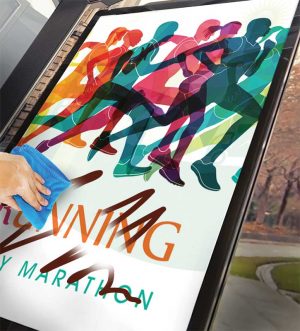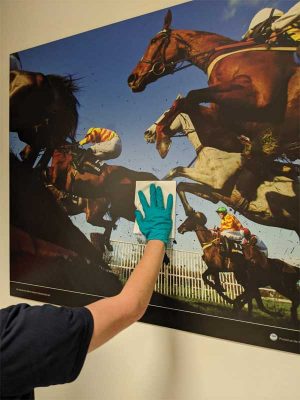Cleaning up: Keeping graphics hygienic without damage
by | 7 August 2020 10:56 am
 [1]
[1]While it is important to ensure the design or message of a graphic remains undamaged by cleaning, in most situations, it is the adhesive that is most crucial.
By David Morgan
It is always important to keep signs and graphics clean for esthetics and clarity of message, but COVID-19 (coronavirus) has made hygiene a priority. Hospitals, transport hubs, and contaminated sites are undertaking deep cleaning to prevent the spread of the virus, ensuring everything—handrails, doors, windows, ceilings, floors, furniture—is sterilized. Many of these surfaces may have graphics applied, possibly communicating essential information. Elsewhere, many businesses and organizations are using downtime to clean their premises from top to bottom now, or will need to sanitize before they reopen at a later date. Retailers, shopping malls, restaurants, bars, museums, galleries, offices, and educational facilities—these will all have signage and graphics that will be part of the cleaning process. With communication key and budgets shrunk, it is essential these printed materials can withstand heavy-duty cleaning without having to be replaced.
Wall murals, decals, floor graphics, window displays, and signage may all need cleaning, but how to approach this will depend on the graphics material, especially that of its overlaminate product. An overlaminate is used to enhance graphics, but is also essential to protect an underlying image or surface from damage caused by ultraviolet (UV) exposure, scratches, graffiti and, indeed, cleaning chemicals.
Choosing the right cleaning solutions
This is where selecting the correct cleaning agent for the graphic media is key. Products typically used for disinfecting are in the aliphatic alcohol or two to five per cent bleach category. These are generally fine for polyvinyl chloride (PVC), polypropylene, polyethylene terephthalate (PET) and polychlorotrifluoroethylene (PCTFE) films, used in the majority of graphics overlaminates. Other types of cleaning agents are in the organic solvent family (acetone, [methyl ethyl ketone], and toluene) to which some products such as PET and PCTFE are highly resistant, but will break down the polymer chains and dissolve PVC material. Polypropylene is generally more durable than PVC, with resistance to some organic solvents, but is still susceptible to attack. Ammonia-based cleaners deserve a further word of caution. Ammonia is considered a corrosive, which can not only make the film brittle, but can also attack the graphic’s adhesive. However, cleaning products that contain ammonia have it diluted in the form of ammonium hydroxide, typically in concentrations no more than 10 per cent. PVC has good resistance to this, but PET is only resistant to solutions up to five per cent—although this is all dependent on temperature and exposure length. If the laminate material is unknown, or if there is any uncertainty, it is safe practice to use only alcohol or bleach-based cleaning products, which are proven disinfectants.
 [2]
[2]Anti-graffiti films are especially designed to tolerate intense cleaning.
While it is important to ensure the printed design or message of a graphic remains undamaged by cleaning, in most situations,
it is the adhesive that is most crucial. Special care is required when cleansing the edges of graphics as disinfectants can weaken the adhesive’s bond to the surface of the graphic, or graphic to the surface such as a window, wall, or floor. Floor graphics, being in a horizontal position, are likely to suffer longer exposure to cleaning products, which may cause a loss of adhesive bond with the floor and, consequentially, result in a trip hazard. Therefore, it is essential to use the correct cleaning agents for the material, follow the instructions, and to avoid longer than necessary exposure. If possible, seal the edges of the graphic following application to prevent ingress of liquid and reduce the risk of weakening the adhesive bond.
Safe and hygienic
Wall and window graphics, while posing less of a safety risk in a tangible sense, lend themselves to more exposure to germs and viruses through hand contact—not to mention the occasional cough or sneeze. However, since they are installed in the vertical position, the duration of exposure to cleaning agents is usually limited, unless the surface is repeatedly saturated. If vinyl graphic edges or seams do begin to lift following cleaning or polishing, there are products on the market that are available to reseal them. Usually sold in pen form, this type of sealant is regularly used by vehicle graphic installers and for wall graphics on overlapping seams.
Take extra care when cleaning specialist applications and media. Laminated photography should be treated as if the laminate is PVC, with attention paid to the edges of the graphics and the duration of exposure to the cleaning agent. For unlaminated print media, check with the printer and/or ink manufacturer for guidance on the ink’s resistance to cleaning chemicals.
Many consumer cleaning products are appropriate for use on professional graphics. Like with any new product or unusual situation, however, it is important to read the label for exact instructions. For instance, Clorox wipes and similar products will require air-drying for full sanitation. Some cleaning fluids may need to be mixed or diluted to achieve the recommended sanitizing solution, so follow those instructions carefully, too.
 [3]
[3]Laminated photography should be treated as if the laminate is PVC, with attention paid to the edges of graphics and the duration of exposure to the cleaning agent.
Take pre-emptive action with media
One can help keep graphics in good visual condition while retaining hygiene by choosing the correct printable media at the outset. As the industry has seen, floor graphics are particularly susceptible to damage, which may then in turn pose a serious trip hazard, so it is essential to use graphics materials and adhesives designed specifically for floor applications. Similarly, there are products developed for fast food and retail counters that feature a moisture barrier for hygiene and protection, while anti-graffiti films are especially designed to tolerate intense cleaning.
There are also products available that not only protect graphics and surfaces, but also actively inhibit the growth of bacteria and micro-organisms. Antimicrobial films are imbued with additives, incorporated during manufacturing to ensure distribution throughout the product, and have been shown to give long-term effectiveness even after regular cleaning with common disinfectants. They should also be resistant to general wear and tear, but a soft cloth should always be used to prevent serious abrasions; again, read the instructions before undertaking any cleaning.
These antimicrobial films can be used as a protective top layer for signs and graphics, but can also be applied to surfaces that are subjected to regular hand contact, such as counters, table-tops, door plates, and control panels. Antimicrobial films may be of particular use in environments such as hospitals, healthcare centres, schools, nurseries, stores, malls, restaurants,
and cafeterias.
Seek advice and stay safe
The spread of COVID-19 has prompted an unprecedented situation. It is essential for everyone, including signage businesses and their customers, to remember they are not alone and advice is available—just ask. Media manufacturers and suppliers, and those of cleaning solutions, will have the correct details and guidance on using their products effectively and safely. Brands, the trade press, and user communities are also doing a great job in sharing information on every issue affecting the industry, big and small.
Finally, it is better to be safe than sorry. No one wants to have to replace signage or display materials unnecessarily, but if a graphic is damaged or cannot be sanitized effectively, it is best to remove it completely and focus on making the surface underneath hygienic. And, while it may seem like the perfect time to spruce up a space, remember to take safety precautions when cleaning. Sign installers must protect themselves from both cleaning products and viruses to stay safe and healthy now and in the future.
With almost 10 years of experience with Drytac, David Morgan currently serves as technical assistance. With his excellent technical knowledge of chemistry and thorough understanding of the graphics market, Morgan offers sound advice on both products and applications. For more information, visit www.drytac.ca[4].
- [Image]: https://www.signmedia.ca/wp-content/uploads/2020/08/protac-emerytex-wipe.jpg
- [Image]: https://www.signmedia.ca/wp-content/uploads/2020/08/Interlam-Pro-anti-graffiti.jpg
- [Image]: https://www.signmedia.ca/wp-content/uploads/2020/08/PHOTO-2020-04-30-10-54-43-1.jpg
- www.drytac.ca: https://www.drytac.com/
Source URL: https://www.signmedia.ca/cleaning-up-keeping-graphics-hygienic-without-damage/